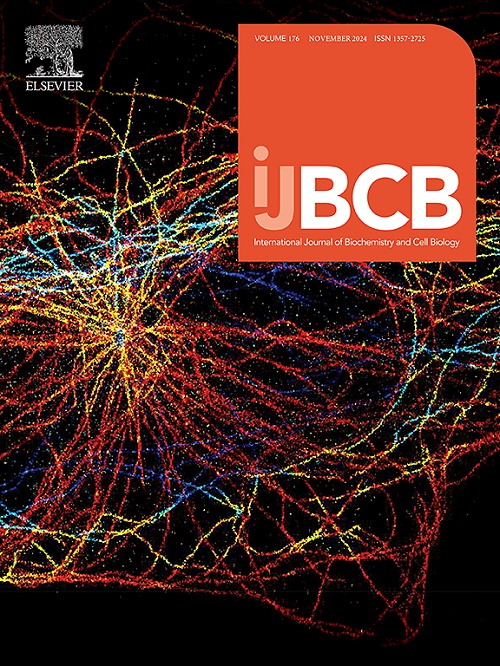CAPRIN1/TYMS/MTHFD2轴促进鼻咽癌发展中的EMT过程
IF 2.8
3区 生物学
Q2 BIOCHEMISTRY & MOLECULAR BIOLOGY
International Journal of Biochemistry & Cell Biology
Pub Date : 2025-04-15
DOI:10.1016/j.biocel.2025.106784
引用次数: 0
摘要
背景鼻咽癌(NPC)是发生在鼻咽部的一种恶性肿瘤。鼻咽癌转移后经常导致治疗失败,这往往是上皮-间质转化(EMT)的结果。胸苷酸合成酶(TYMS)是参与 DNA 合成和复制的关键酶。目前,TYMS在鼻咽癌EMT中的作用及其上下游机制尚不清楚。本研究使用携带 TYMS 敲除和过表达质粒的慢病毒来调控 TYMS 的表达。分别使用伤口愈合和 Transwell 试验检测细胞迁移和侵袭。将 C666-1 细胞分别注射到小鼠的腋窝和尾静脉以形成皮下肿瘤和构建肺转移模型。采用 RNA 免疫沉淀法检测蛋白质与 mRNA 之间的相互作用。结果TYMS在鼻咽癌组织中高表达。TYMS的沉默和上调分别抑制和促进了鼻咽癌细胞的EMT过程,EMT相关蛋白(包括E-cadherin、Slug、MMP2和MMP9)的表达证明了这一点。细胞质活化/增殖相关蛋白-1(CAPRIN1)是一种与TYMS mRNA结合的蛋白,可促进鼻咽癌细胞的EMT过程。同时,TYMS基因敲除可逆转CAPRIN1过表达的影响。TYMS沉默后,亚甲基四氢叶酸脱氢酶2(MTHFD2)下调。结论CAPRIN1/TYMS/MTHFD2轴驱动EMT过程,从而促进鼻咽癌的发展,是治疗和辅助治疗鼻咽癌的一个很有前景的靶点。本文章由计算机程序翻译,如有差异,请以英文原文为准。
CAPRIN1/TYMS/MTHFD2 axis promotes EMT process in nasopharyngeal carcinoma development
Background
Nasopharyngeal carcinoma (NPC) is a type of malignant tumor occurring in the nasopharynx. It frequently leads to treatment failure after metastasis, often resulting from epithelial-mesenchymal transition (EMT). Thymidylate synthetase (TYMS) is a key enzyme involved in DNA synthesis and replication. Currently, the role of TYMS and its mechanism of upstream and downstream in EMT of NPC is unclear.
Methods
NPC cell lines HK-1 and C666–1 were used in this study. Lentivirus carrying TYMS knockdown and overexpressed plasmids were used to regulate TYMS expression. Cell migration and invasion were examined using the wound-healing and Transwell assays, respectively. C666–1 cells were injected into the axilla and tail vein of mice to form subcutaneous tumors and construct lung metastasis model, respectively. RNA immunoprecipitation assay was used to examine the interaction between protein and mRNA. RNA-seq was performed to explore the downstream regulatory mechanism of TYMS.
Results
TYMS was highly expressed in NPC tissues. TYMS silencing and upregulation inhibited and promoted EMT processes in NPC cells, respectively, as demonstrated by the expression of EMT-related proteins, including E-cadherin, Slug, MMP2, and MMP9. Cytoplasmic activation/proliferation-associated protein-1 (CAPRIN1), a protein bound with TYMS mRNA, promoted the EMT process in NPC cells. Meanwhile, TYMS knockdown reversed the effect of CAPRIN1 overexpression. Methylenetetrahydrofolate dehydrogenase 2 (MTHFD2) was down-regulated following TYMS silencing. MTHFD2 knockdown abolished the effect of TYMS overexpression.
Conclusion
CAPRIN1/TYMS/MTHFD2 axis drives the EMT process and thus promotes NPC development, which is a promising target in therapy and adjuvant therapy of NPC.
求助全文
通过发布文献求助,成功后即可免费获取论文全文。
去求助
来源期刊
CiteScore
8.10
自引率
0.00%
发文量
124
审稿时长
19 days
期刊介绍:
IJBCB publishes original research articles, invited reviews and in-focus articles in all areas of cell and molecular biology and biomedical research.
Topics of interest include, but are not limited to:
-Mechanistic studies of cells, cell organelles, sub-cellular molecular pathways and metabolism
-Novel insights into disease pathogenesis
-Nanotechnology with implication to biological and medical processes
-Genomics and bioinformatics

 求助内容:
求助内容: 应助结果提醒方式:
应助结果提醒方式:


